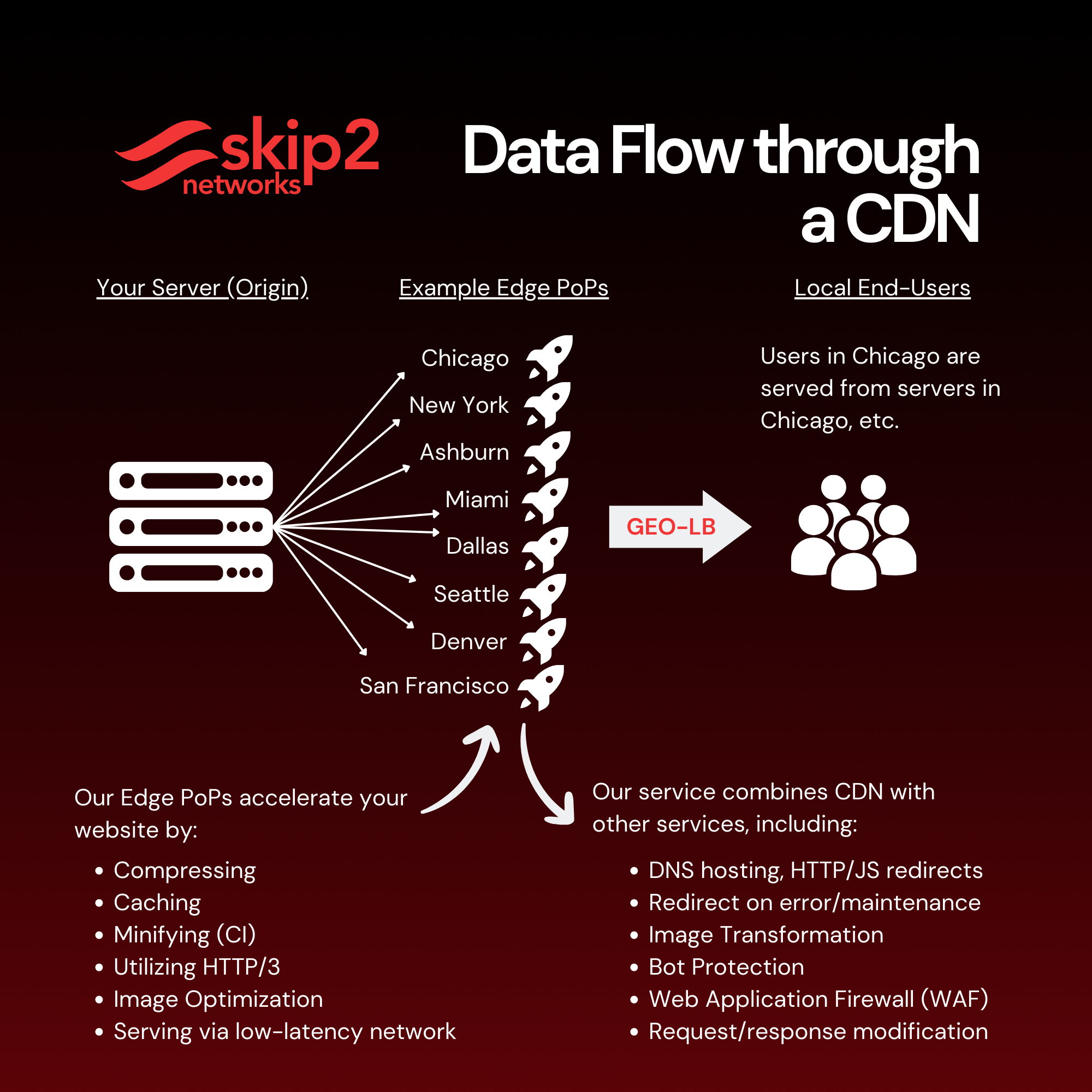- Published on
Impact of CDN on Global Internet Accessibility and Performance
- Authors

- Name
- Alex Lee
- Title
- CEO
- @alexjoelee
Content Delivery Networks (CDN) have become increasingly popular in recent years, due to their ability to improve global internet accessibility and performance. CDNs are networks of servers located around the world that store copies of websites and content, allowing users to access this information more quickly and reliably than they would be able to if they were accessing the original source. In this article, we’ll explore how CDNs can be used to boost internet accessibility, the impact they have on network performance, as well as the advantages and disadvantages of implementing CDN. We’ll also provide an overview of the benefits and drawbacks of using CDN so that organizations can make an informed decision about its implementation. 
Overview of CDN and its impact on global internet accessibility and performance
Content Delivery Networks (CDNs) are a key component of the internet infrastructure, and their role in improving global internet accessibility and performance is becoming increasingly important. A CDN is a network of geographically distributed servers that store copies of websites and content. By utilizing these networks, users can access content more quickly, reliably, and securely regardless of where they are in the world.
When it comes to global internet accessibility, CDNs provide two main advantages: faster load times and improved scalability. With faster load times, users have access to websites and content much quicker than if they were accessing the original source. This reduces page abandonment rates and increases user satisfaction. Additionally, CDNs improve scalability by allowing organizations to handle spikes in traffic without having to invest heavily in additional server resources.
In terms of performance, CDNs can have a significant impact on website loading speed and user experience. By caching content at various points around the world, CDNs reduce latency – which means that websites will load more quickly for users no matter where they are located. Additionally, as traffic increases or decreases over time, CDNs allow organizations to scale up or down quickly without having to worry about extra server costs or capacity issues.
Finally, there are a variety of technologies associated with CDN that organizations should be aware of when considering implementing them into their infrastructure. These technologies include caching domains for static resources such as images and videos; edge-computing capabilities for dynamic requests; geographic redirects; advanced analytics services; origin shield protection from DDoS attacks; HTTP/3 QUIC protocol support; TLS encryption support; API gateways; real-time monitoring systems, quality assurance testing tools; streaming media optimization services and more.
By leveraging these technologies effectively together with efficient architectures such as mesh nodes or anycast routing methods, organizations can maximize the benefits available through implementing a Content Delivery Network into their internet infrastructure while minimizing any potential drawbacks.
How CDN boosts internet accessibility
Content Delivery Networks (CDN) are a powerful tool for boosting internet accessibility. CDNs typically have nodes across the globe, which helps to reduce latency and increase access speeds. By caching content on its nodes, CDNs can help reduce bandwidth costs for content providers, as well as improve scalability. This ensures that users have a reliable source of content delivery, as CDNs are able to continuously monitor and adjust their networks to ensure that content is delivered efficiently.
Another way in which a CDN helps boost internet accessibility is by providing a more secure environment for users. CDNs filter out malicious traffic and protect against DDoS attacks, making it difficult for hackers to take advantage of unprotected networks or systems. Additionally, CDNs can also provide additional security layers such as encryption and authentication protocols to further protect user data from being intercepted or stolen.
Finally, by utilizing various technologies associated with their CDN services, such as compression, edge computing capabilities, and redundant datacenters, organizations can create an even better user experience by improving website loading speed and reducing latency when accessing websites or applications from anywhere in the world. As a result, CDN can be used to make sure that users always have access to the best-performing version of a website or application regardless of where they’re located or what device they’re using.
Overall, Content Delivery Networks offer many advantages when it comes to boosting global internet accessibility and performance – from improved speeds and scalability to enhanced security features. By leveraging these technologies into their operations, organizations can help ensure that their customers are getting the best possible experience no matter where they may be located in the world. 
What is the effect of CDN on network performance?
The implementation of a Content Delivery Network (CDN) can have an impressive effect on the performance of networks. Not only does it help decrease latency and boost page loading speeds, but it also provides additional security and reliability.
Faster page load times provide better user experiences and can increase customer satisfaction. Studies have shown that even a one-second delay in page load time can cause customers to abandon a website completely. Fortunately, CDNs are designed to optimize data delivery by caching content on servers around the world which helps reduce latency and maximize page loading speeds for all users regardless of location or device type.
In addition to its other benefits, CDNs also offer an extra layer of protection against malicious attacks such as DDoS or any other cyber threats. By filtering out malicious traffic at the edge before it reaches any other server or network component, organizations can create a secure environment for their users and customers alike.
Overall, using a CDN is beneficial for any organization looking to improve global internet accessibility and performance. With its various technologies such as caching domains, edge computing capabilities, geographic redirects etc., organizations are able to take full advantage of reduced latency rates, increased scalability and strengthened security measures when implementing a CDN solution into their business model.
Advantages and disadvantages of implementing CDN
Content Delivery Networks (CDN) offer a range of benefits for organizations looking to optimize global internet access and performance. The primary benefit is improved download rates - CDNs can reduce page loading times by caching content around the globe, cutting down on latency. This means that customers’ experience is smoother, faster, and more enjoyable. Plus, with CDN, scalability of websites and applications increases. Through edge computing capabilities, companies can guarantee their services are available even during peak usage periods or sudden surges in traffic.
From a safety standpoint, a CDN provides an additional layer of security against DDoS attacks by filtering out malicious traffic before it reaches the server. This lowers the chances of data breaches or other cyber threats damaging an organization’s online presence. Moreover, with geographic redirects and content delivery networks in different countries, businesses can reach more customers all over the world without needing to invest in extra infrastructure or hosting fees.
Nevertheless, there are some drawbacks attached to implementing a CDN, too. For instance, while CDNs can accelerate downloads for customers located close to their servers; they may increase latency for those situated further away due to having to wait for content from distant nodes. Additionally, if an organization isn’t careful about how they configure their CDN network it could result in higher hosting fees as well as extra resources necessary to maintain it accurately. Lastly, even though Content Delivery Networks improve security by blocking malicious traffic; there is still potential for data breaches or other cybersecurity risks if not done correctly.
In general, Content Delivery Networks deliver many benefits when it comes to optimizing global internet availability and performance such as faster download speeds and increased scalability while also providing added security protection against DDoS attacks and other cyber threats. Organizations should take into account both advantages versus drawbacks before deciding whether or not to implement a Content Delivery Network so they can make an informed decision regarding its use within their business structure
Conclusion and summary
Content Delivery Network (CDN) is a powerful tool for improving global internet access and performance. It can provide an array of advantages, such as faster loading times, increased scalability and enhanced security features to protect against malicious traffic. However, there are potential drawbacks to consider, such as higher hosting fees and the risk of data breaches if not configured correctly.
Due to these tradeoffs, organizations should carefully assess their goals before investing in CDN implementation. When executed properly, CDN can be extremely beneficial in terms of improved download speeds and better user experience. On the other hand, it may not be worth the cost for organizations that lack the resources or expertise needed to set up and manage a content delivery network successfully.
In conclusion, CDN has clear benefits but also potential risks associated with its implementation that need to be taken into account beforehand. Organizations should study all relevant factors before deciding on whether or not to benefit from this technology so as to guarantee optimal performance. With the right setup and strategy in place, businesses can reap tremendous rewards from adopting content delivery networks - improved loading times coupled with increased security measures being just a couple of them.